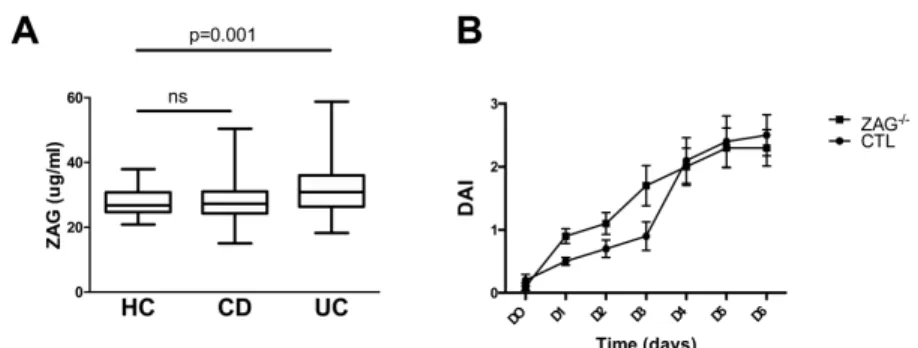HAL Id: hal-02401061
https://hal.archives-ouvertes.fr/hal-02401061
Submitted on 9 Dec 2019
HAL is a multi-disciplinary open access
archive for the deposit and dissemination of
sci-entific research documents, whether they are
pub-lished or not. The documents may come from
teaching and research institutions in France or
abroad, or from public or private research centers.
L’archive ouverte pluridisciplinaire HAL, est
destinée au dépôt et à la diffusion de documents
scientifiques de niveau recherche, publiés ou non,
émanant des établissements d’enseignement et de
recherche français ou étrangers, des laboratoires
publics ou privés.
Zinc-Alpha-2-Glycoprotein in Inflammatory Bowel
Disease
Véronique Rolli, Cécile Macquin, Tunay Kokten, Julie Hablot, Ndeye-Coumba
Ndiaye, Patrick Netter, Seiamak Bahram, Jean-Yves Jouzeau, Laurent
Peyrin-Biroulet, Philippe Georgel, et al.
To cite this version:
Véronique Rolli, Cécile Macquin, Tunay Kokten, Julie Hablot, Ndeye-Coumba Ndiaye, et al..
Zinc-Alpha-2-Glycoprotein in Inflammatory Bowel Disease. Inflammatory Bowel Diseases, Lippincott,
Williams & Wilkins, 2018, 24 (5), pp.e10. �10.1093/ibd/izy120�. �hal-02401061�
Inflamm Bowel Dis • Volume 24, Number 5, May 2018
e10
L
etterto thee
ditorZinc-Alpha-2-Glycoprotein
in Inflammatory Bowel
Disease
To the Editors,
Zinc-Alpha-2-Glycoprotein (ZAG), a 40 kDa soluble protein present in various body fluids (serum, urine, sem-inal fluid, saliva, and milk), controls adi-pose tissue mobilization in the context of cachexia.1–3 Inflammatory Bowel Diseases
(IBD), including Crohn’s disease (CD) and ulcerative colitis (UC), have been historically associated with cachexia and malnutrition. Furthermore, a recent con-nection between ZAG and Th17 lympho-cyte, a subpopulation of adaptive immune cell involved in both mucosal homeostatic microbial protection and IBD occurring inflammation has been made, suggesting a vicious cycle worsening inflammation and metabolic disorder in systemic inflamma-tory disease.4 We thus explored the
poten-tial role of ZAG in IBD.
We first measured serum levels of ZAG using ELISA in IBD patients, UC (n = 70) and CD (n = 109), enrolled in the “Nancy IBD cohort” and healthy controls (n = 105). ZAG levels are significantly increased in patients with UC (31,4 ± 8 µg/ml vs 27,6 ± 3,8 µg/ml; P = 0.0019), whereas no statistical difference is observed in patients with CD (28,2 ± 6,5 µg/ml) (Fig. 1A). This prompted us to look in the animal model of colitis. We thus induced dextran sodium sulfate (DSS) colitis in ZAG-/- mice (n = 12) and wild-type animals (n = 11). Severity of col-itis, measured by disease activity score (Fig. 1B), daily fecal lipocalin2 dos-age (not shown), and final histological examination (not shown) revealed no difference between wild-type and ZAG deficient mice.
Taken together, these data suggest that ZAG might only reflect inflamma-tion occurring in patients with UC, as animal data are not in favor of a direct role in IBD pathophysiology.
Véronique Rolli, PhD,*
Cécile Macquin, MSc,*
Tunay Kokten, PhD,
†Julie Hablot, MSc,
‡Ndeye-Coumba Ndiaye, PhD,
†Patrick Netter, MD, PhD,
‡Seiamak Bahram, MD, PhD,*
Jean-Yves Jouzeau, PharmD,
PhD,
‡Laurent Peyrin-Biroulet,
MD, PhD,
†Philippe Georgel,
PhD,*
,¶and David Moulin,
PhD
‡,§,¶*Immunorhumatologie Moléculaire, UMR_S 1109, Strasbourg, France; †NGERE, UMR_
S954 INSERM-Université de Lorraine, Vandœuvre Les Nancy, France;
‡IMoPA, UMR7365 CNRS-Université
de Lorraine, Vandœuvre Les Nancy,
France; §CHRU de Nancy, Contrat
d’interface, Vandœuvre Les Nancy, France
Supported by: This work was supported partly by the French PIA project « Lorraine Université d’Excellence », reference ANR-15-IDEX-04-LUE; INSERM UMR_S 1109 and Institut Universitaire de France. ¶These authors contributed equally to this work.
Conflicts of Interest: Authors have no conflict of interest to declare.
Address correspondence to: Philippe Georgel, PhD, ImmunoRhumatologie Moléculaire, INSERM UMR_S 1109 Université de Strasbourg, Centre de Recherche d’Im-munologie et d’Hématologie, 1 Place de l’Hopital, 67085 Strasbourg France. E-mail: pgeorgel@unistra.fr
REFERENCES
1. Hassan MI, Waheed A, Yadav S, et al. Zinc alpha 2-glycoprotein: a multidisciplinary protein. Mol
Cancer Res. 2008;6:892–906.
2. Rolli V, Radosavljevic M, Astier V, et al. Lipolysis is altered in MHC class I zinc-al-pha(2)-glycoprotein deficient mice. FEBS Lett. 2007;581:394–400.
3. Balaz M, Ukropcova B, Kurdiova T, et al. Adipokine zinc-α2-glycoprotein regulated by growth hormone and linked to insulin sensitivity.
Obesity (Silver Spring). 2015;23:322–8.
4. Na HS, Kwon JE, Lee SH, et al. Th17 and IL-17 cause acceleration of inflammation and fat loss by inducing α2-glycoprotein 1 (AZGP1) in rheu-matoid arthritis with high-fat diet. Am J Pathol. 2017;187:1049–58.
© 2018 Crohn’s & Colitis Foundation. Published by Oxford University Press. All rights reserved. For permissions, please e-mail: journals.permissions@oup.com.
doi: 10.1093/ibd/izy120
FIGURE 1. A, ZAG protein level is elevated in UC patients. Plasmatic levels of ZAG were meas-ured by ELISA in UC (n = 70), CD (n = 109), and healthy controls (n = 105). B, DSS occurrence
and severity is not altered in ZAG deficient mice. DSS Colitis was induced by administration
of 3% DSS (Colitis grade MW 36-50kDa) (MPBiomedicals) in drinking water for 6 days in control and ZAG deficient mice. Daily, the severity of colitis was evaluated by the disease activity index (DAI). The DAI was calculated with the body weight loss (0 = no weight loss, 1 = 0%-5% weight loss, 2 = 5%-10% weight loss, 3 = 10%-20% weight loss, 4 = more than 20% weight loss); feces consistency (0 = normal, 2 = loose stools, 4 = diarrhea); and the presence of blood in the feces (0 = negative, 2 = positive, 4 = important presence of blood in the feces).
Published online 23 April 2018 in academic.oup.com/ibdjournal
Downloaded from https://academic.oup.com/ibdjournal/article-abstract/24/5/e10/4982892
by Music Library, School of Music, National Institute of the Arts, Australian National University user on 26 April 2018
